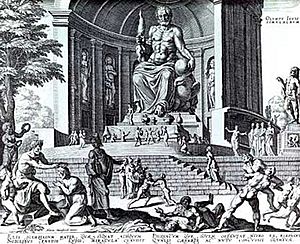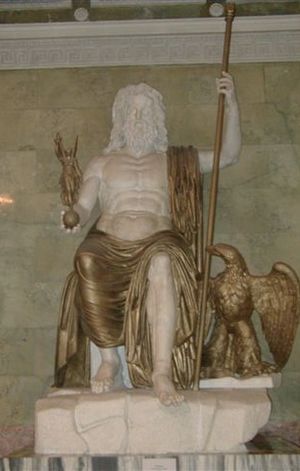Statue of Zeus at Olympia facts for kids
The Statue of Zeus at Olympia was a super-sized statue of the Greek god Zeus. It was about 12.4 meters (41 feet) tall, which is like a four-story building! The famous Greek artist Phidias made it around 435 BC.
This amazing statue stood in the Temple of Zeus in Olympia, Greece. Zeus was the most important god in ancient Greece. He was known as the king of the gods who lived on Mount Olympus.
The statue was a special type called a chryselephantine sculpture. This means it was made from ivory plates and gold panels placed over a wooden frame. Zeus sat on a throne made of cedarwood. This throne was decorated with fancy materials like ebony, ivory, gold, and shiny jewels. The Statue of Zeus was so impressive that it was named one of the Seven Wonders of the Ancient World.
Sadly, the statue was lost and destroyed sometime in the 400s AD. We only know what it looked like from old Greek writings and pictures found on ancient coins.
History of the Zeus Statue
The people of Elis, who were in charge of the Olympic Games, ordered the Statue of Zeus to be built. This happened in the late 400s BC, for their new Temple of Zeus. They wanted their temple to be even grander than the ones in Athens. So, they hired Phidias, a very famous sculptor. He had already created the huge statue of Athena Parthenos for the Parthenon in Athens.
The statue was so big it took up half the width of the temple's main hallway. A writer named Strabo said that if Zeus were to stand up, he would hit his head on the roof! The Zeus statue was made with ivory and gold pieces over a wooden base. No copies of it made from marble or bronze have been found. However, we can see rough ideas of it on coins from nearby Elis and on old Roman coins and carved gems.
A traveler and writer named Pausanias wrote a detailed description of the statue in the 100s AD. He said Zeus wore a sculpted wreath of olive branches on his head. His robe was made of gilded (gold-covered) glass and had carvings of animals and lilies. In his right hand, Zeus held a smaller statue of Nike, the goddess of victory. In his left hand, he held a scepter (a royal staff) decorated with different metals, and an eagle sat on top of it.
The throne itself was a work of art. It had painted figures and carved images. It was also decorated with gold, precious stones, ebony, and ivory. Zeus's golden sandals rested on a footstool. This footstool had a carving showing a battle between the Amazons (a group of warrior women) and Greeks. The area under the throne was hidden by painted screens.
Pausanias also mentioned that the statue was always covered in olive oil. This was to protect the ivory from the damp air of the Altis grove where the temple stood. The floor in front of the statue was made of black tiles. It had a raised marble edge to hold the oil. This pool of oil also acted like a reflecting pool, making the statue look even taller!
According to the Roman historian Livy, the Roman general Aemilius Paullus saw the statue and felt deeply moved. He said it was like seeing the god himself. Another Greek speaker, Dio Chrysostom, said that just one look at the statue would make a person forget all their problems.
There's a story that someone asked Phidias what inspired him to create Zeus. They wondered if he had climbed Mount Olympus to see Zeus, or if Zeus had come down to him. Phidias replied that he imagined Zeus based on a description from Homer's famous poem, the Iliad. The lines he used described Zeus nodding his head, making his divine hair flow, and shaking Mount Olympus.
It's also said that Phidias honored a young wrestler named Pantarkes. Pantarkes won the boys' wrestling event at the Olympic Games. Phidias supposedly carved "Pantarkes is beautiful" onto Zeus's little finger. He also placed a carving of the boy crowning himself at the statue's feet.
Pausanias also wrote about a legend that happened when the statue was finished. Phidias asked Zeus for a sign to show if he liked the work. Right away, a thunderbolt supposedly struck the floor. A bronze jar was later placed there to mark the spot.
Loss and Destruction of the Statue
The exact way the Statue of Zeus was destroyed is not fully known. According to the Roman historian Suetonius, the Roman Emperor Caligula wanted to move famous statues of gods from Greece to Rome. He planned to remove their heads and replace them with his own! This included the Statue of Zeus at Olympia. However, Caligula was killed in 41 AD before he could do this. Legend says the statue itself predicted his death by letting out a huge laugh, which made the scaffolding around it fall down.
In 391 AD, the Christian Roman emperor Theodosius I made it illegal to worship pagan gods. He also closed down pagan temples. The sanctuary at Olympia was no longer used after this.
One idea is that the statue was taken to Constantinople (modern-day Istanbul). A historian named Georgios Kedrenos wrote in the 1000s AD that it was destroyed there in a big fire in 475 AD. This fire happened in a palace called the Palace of Lausus.
Another idea is that the statue was destroyed along with the temple itself. The temple was badly damaged by fire around 425 AD. However, a writer named Lucian mentioned the statue being damaged or stolen in the late 100s AD. He wrote, "they have laid hands on your person at Olympia, my lord High-Thunderer, and you had not the energy to wake the dogs or call in the neighbours; surely they might have come to the rescue and caught the fellows before they had finished packing up the loot." This suggests it might have been damaged or stolen even earlier.
Phidias' Workshop
The time period when the statue was made (the late 400s BC) was confirmed by an exciting discovery. Between 1954 and 1958, archaeologists found Phidias' workshop! It was located exactly where Pausanias said the Statue of Zeus was built.
Inside the workshop, they found tools used for working with gold and ivory. They also found small pieces of ivory, precious stones, and clay molds. Many of these molds were used to make glass pieces. These glass pieces were then shaped to look like the folds of the statue's robe and covered in gold. A cup was also found with the words "ΦΕΙΔΙΟΥ ΕΙΜΙ" carved on it, which means "I belong to Phidias."
|
See also
 In Spanish: Estatua de Zeus en Olimpia para niños
In Spanish: Estatua de Zeus en Olimpia para niños







